Abstract
The osprey optimization algorithm (OOA) is a new metaheuristic motivated by the strategy of hunting fish in seas. In this study, the OOA is applied to solve one of the main items in a power system called economic load dispatch (ELD). The ELD has two types. The first type takes into consideration the minimization of the cost of fuel consumption, this type is called ELD. The second type takes into consideration the cost of fuel consumption and the cost of emission, this type is called combined emission and economic dispatch (CEED). The performance of the OOA is compared against several techniques to evaluate its reliability. These methods include elephant herding optimization (EHO), the rime-ice algorithm (RIME), the tunicate swarm algorithm (TSA), and the slime mould algorithm (SMA) for the same case study. Also, the OOA is compared with other techniques in the literature, such as an artificial bee colony (ABO), the sine cosine algorithm (SCA), the moth search algorithm (MSA), the chimp optimization algorithm (ChOA), and monarch butterfly optimization (MBO). Power mismatch is the main item used in the evaluation of the OOA with all of these methods. There are six cases used in this work: 6 units for the ELD problem at three different loads, and 6 units for the CEED problem at three different loads. Evaluation of the techniques was performed for 30 various runs based on measuring the standard deviation, minimum fitness function, and maximum mean values. The superiority of the OOA is achieved according to the obtained results for the ELD and CEED compared to all competitor algorithms.
MSC:
68Txx
1. Introduction
An important optimization issue for a power system’s efficient and trouble-free operation is the economic load dispatch (ELD). The net electricity demand is rising alarmingly quickly. As a result, the cost of fuel for producing electricity is also rising. Therefore, to ensure power systems operate reliably, it is necessary to lower operational costs. By maximizing the thermal units’ ability to produce energy, the ELD issue aims to lower the system’s running costs while also enhancing the system’s dependability. The combined economic emission dispatch (CEED) problem is a result of the tendency in recent years to consider cost and pollution while planning and operating power systems [1,2]. As a result, ELD and CEED are intricate power system optimization problems with nonlinear fitness functions, equality requirements, and inequality constraints. Because the ELD problem is not linear, standard techniques are only partially effective in addressing it. Different metaheuristic methods have been suggested by researchers to address such issues. The benefits of metaheuristic algorithms have confirmed the effectiveness of other approaches in dealing with complex optimization problems [3,4,5].
To determine the real and reactive power of the electrical generation system, the linear programming approach was utilized; however, such methods have a significant calculation time and are occasionally unable to offer a global solution for huge data sets [6]. The pattern search approach was suggested as a way to find the best solution to the ELD problem, and the impacts of valve loading were considered. To validate the findings, the suggested algorithm was evaluated on a variety of test data and compared to existing optimization methods [7]. Transmission losses, dynamic operation limitations, and restricted operating zones were all employed in conjunction with the ELD problem in the PSO approaches [8]. The ELD issue, which comprises a DC load flow and network security limitations, was solved using quadratic programming [9].
Numerous metaheuristic (MH) methods have been developed to address the ELD issue in the same setting. These MH techniques may be broadly divided into four sorts of algorithms: evolutionary, swarm-based, physical-based, and human-based. All of these types simulate swarm activity or other natural phenomena to find the best solution.
Recently, many optimization algorithms, such as the white shark optimizer [10], the search and rescue optimization algorithm (SAR) [11], the greedy sine-cosine nonhierarchical gray wolf optimizer (G-SCNHGWO) [12], the efficient chameleon swarm algorithm (CSA) [13], the memetic sine cosine algorithm [14], the hybrid Harris hawks optimizer (HHO) [15], the oppositional pigeon-inspired optimizer (OPIO) algorithm [16], the modified krill herd algorithm [17], the modified differential evolution algorithm [18], artificial eco system-based optimization [19], turbulent flow of water optimization (TFWO) [20], particle swarm optimization (PSO) [21], evolution strategy (ES) [22], teaching learning based optimization (TLBO) [23], the modified symbiotic organisms search algorithm (MSOS) [24], civilized swarm optimization (CSO) [25], the ant lion optimization algorithm (ALO) [26], the efficient distributed auction optimization algorithm (DAOA) [27], the hybrid grey wolf optimizer (HGWO) [28], the improved genetic algorithm (IGA) [29], the improved firefly algorithm (IFA) [30], biogeography-based optimization (BBO) [31], the heat transfer search (HTS) algorithm [32], adaptive charged system search (ACSS) [33], the evolutionary simplex adaptive Hooke–Jeeves algorithm (ESAHJ) [34], the enhanced moth-flame optimizer (EMFO) [35], multi-strategy ensemble biogeography-based optimization (MSEBBO) [36], several new hybrid algorithms [37], a fully decentralized approach (DA) [38], the exchange market algorithm (EMA) [39], bacterial foraging optimization (BFO) [40], the artificial cooperative search algorithm (ACS) [41], a new firefly algorithm (FA) via a non-homogeneous population [42], a modified chaotic artificial bee colony (MABC) [43], a distributed auction based algorithm (AA) [44], the one rank cuckoo search algorithm (ORCSA) [45], and the modified crow search algorithm (MCSA) [46] have been employed to find the optimal solution for the ELD problem. The description of each work is presented in Table 1.

Table 1.
Literature survey for each method.
According to the no free lunch (NFL) formula [47,48,49,50,51], different metaheuristics perform and behave differently when tackling diverse classes of problems. One cutting-edge metaheuristic approach to solving the ELD problem is the osprey optimization algorithm (OOA) [52]. The OOA method is simple to implement due to its straightforward formula, few parameters, and fundamental idea.
The main points of contribution and objectives in this paper are illustrated as follows:
- To discuss two network studies: ELD with various load demands and CEED with various load demands.
- A new metaheuristic technique called osprey optimization algorithm (OOA) is applied to solve the ELD and CEED problems.
- The proposed OOA method is compared with the rime-ice algorithm (RIME), the tunicate swarm algorithm (TSA), the slime mould algorithm (SMA), and elephant herding optimization (EHO) for the same case study.
The paper is organized as follows: the CEED and ELD issues are deliberated in section two. The OOA method is discussed in section three. The discussion of the results is presented in section four. The conclusions and areas for future work are depicted in section five.
2. Economic Load Dispatch Problem
One of the problems with the operation of power systems is ELD. The primary challenge in solving the ELD issue is reducing fuel consumption expenses to maximize the economic advantage for power plants. The primary variable in the ELD issue defines the vector for distributing resources so that each unit produces the most power. Following is a discussion of CEED and ELD analysis with losses.
2.1. ELD
The mathematical equations of ELD with losses can be labeled as follows. To run n generators, the consumption fuel cost will be pinpointed as follows:
where F stands for the net fuel cost, F1 for the cost of fuel in the first generator, and Fn for the cost of fuel in the nth generator. The following methods will be used to obtain a function of consumption fuel cost in quadratic form:
where a, b, and c stand for the fuel cost’s weight constants. Additionally, using Equations (3) and (5), the generator constraints for each unit can be varied from zero up to 500 MW.
where denotes the total demand of the network and denotes 6 transmission losses of the network which can be calculated as follows:
where refers to the loss factor, refers to the generated power at the ith generator, and refers to the generated power at the jth generator.
2.2. CEED
Progress on the ELD issue can be achieved by considering the reduction of emission costs alongside the production cost, which is defined as the CEED. The factor of emission can be mathematically calculated by:
The CEED objective function is calculated according to the following equation:
where refers to the penalty factor for the price as given in Equation (8):
The generator constraints in each unit are accounted for by Equations (3) and (5).
3. Osprey Optimization Algorithm
In this section, the recent osprey optimization algorithm (OOA) is presented, and then the mathematical modeling is presented [52].
3.1. Inspiration of OOA
The osprey, often referred to as the fish, river, and sea hawk, is a nocturnal fish-eating bird of prey with a wide geographic range. A clever natural behavior that can serve as the foundation for creating a new optimization algorithm is the osprey approach of catching fish and carrying them to an advantageous location to consume them. To build the suggested OOA method, which is covered in the following section, these intelligent osprey behaviors were mathematically modeled.
3.2. Mathematical Modelling
The procedure of updating the positions of ospreys in the two phases of exploration and exploitation based on the simulation of natural osprey behavior is presented [52] after the startup of the OOA is detailed in this subsection.
3.2.1. Initialization
The suggested OOA is a population-based strategy that, using a repetition-based method, can find a workable solution based on the search power of its population members in the problem-solving space. Based on its location in the search space, each osprey calculates the values of the problem variables as a member of the OOA population. As a result, each osprey represents a potential solution to the issue, represented numerically by a vector. The OOA population, which is made up of all ospreys, can be described using a matrix per Equation (9). Using Equation (10), the location of ospreys in the search space is initialized at random at the start of the OOA implementation. To be specific, the factors mentioned in Equations (2) and (6) are represented by as defined in Equation (10).
where represents the population matrix of the locations of the ospreys, represents the th osprey (a candidate solution), represents its th dimension (problem variable), represents the number of ospreys, m represents the number of problem variables, represents random numbers in the range , and represent the lower bound and upper bound.
The objective function defined in Equations (3) and (7) can be assessed since each osprey is a potential solution to the problem that corresponds to that particular osprey. According to Equation (11), a vector can be used to represent the evaluated values for the problem’s objective function.
where is the calculated objective function value for the th osprey and is the vector of the objective function values.
The primary criteria for assessing the quality of potential solutions are the values evaluated for the objective function. The best candidate solution (i.e., the best member) corresponds to the best value found for the objective function, and the worst candidate solution (i.e., the worst member) corresponds to the worst value obtained for the objective function. The best candidate solution must be modified in each iteration since the location of the ospreys in the search space is updated on each iteration.
3.2.2. Phase 1: Identification of Positions and Hunting of Fish (Exploration)
Ospreys are powerful hunters with great eyesight that allows them to locate fish underwater. They locate the fish, attack it, and chase the fish by diving under the surface. The first stage of the OOA’s population update was modeled using a simulation of ospreys’ actual natural behavior. The position of the osprey in the search space changed significantly as a result of modeling the osprey attack on fish, increasing the exploration capacity of the OOA in locating the ideal location and eluding the local optima.
The placements of other ospreys in the search space that have a higher objective function value were regarded as undersea fishes for each osprey in the OOA design. Using Equation (12), the set of fish for each osprey was determined as:
where is the fish position set for the ith osprey and is the best osprey solution.
One of these fish is randomly located by the osprey, which then strikes it. Using Equation (13), a new position for the matching osprey was determined based on the simulation of the osprey’s movement towards the fish. According to Equation (14), the osprey will move to this new position if it enhances the value of the objective function.
where is the th osprey new position based on the first phase of OOA, is its th dimension, is its fitness function, is the fish selected for th osprey, is the th dimension, are random numbers in the interval , and are random numbers from the set .
3.2.3. Phase 2: Carrying the Fish to the Suitable Location Position (Exploitation)
The osprey carries a fish it has caught to a good location where it will consume it. Based on a simulation of this real behavior, the second stage of updating the population in the OOA was modeled. The osprey’s position in the search space was created by small changes caused by modeling the carrying of the fish to the proper position, which increased the OOA’s exploitation power in the local search and caused convergence towards better solutions close to the discovered solutions. In the OOA design, a new random position was initially determined for each member of the population as a “suitable position for eating fish” using Equation (15). This simulated the natural behavior of ospreys.
Then, per Equation (16), it replaced the former location of the related element if the value of the objective function was enhanced in this new position.
where is the th osprey new position based on the second phase of the OOA, is the th dimension, is its fitness function, are random numbers in the interval is the iteration counter of the method, and is the total number of iterations.
3.3. Repetition Process, Flowchart, and Pseudocode of OOA
The first iteration of the planned OOA was finished by revising all of the ospreys’ positions according to the first and second stages. The best candidate solution was then modified based on a comparison of the values of the objective function. The algorithm then moved on to the following iteration with the revised osprey placements, and so forth until the last iteration based on Equations (12)–(16). The best candidate solution saved during the iterations is finally presented as a solution to the problem after the algorithm was fully implemented. The chart in Figure 1 and accompanying pseudocode in Algorithm 1 [52] show the OOA implementation processes.
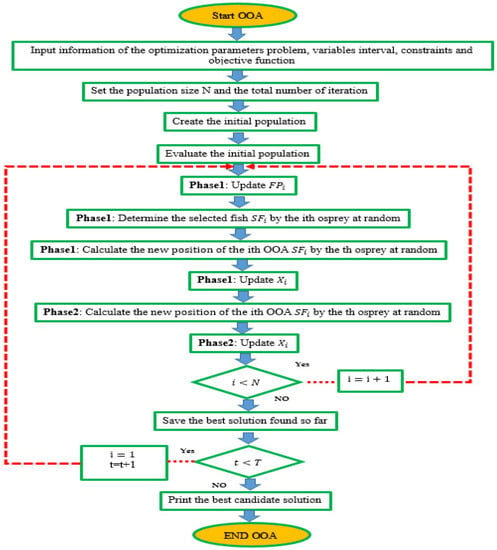
Figure 1.
Flow chart of OOA method.
4. Analysis and Discussion of Results
The OOA performance for the two issues of ELD and CEED is presented. The proposed OOA method was compared with the tunicate swarm algorithm (TSA) [53], the RIME [54], the SMA [55] and elephant herding optimization (EHO) [56]. The ELD problem was first applied as a case study for 6 units at three load demand values (700, 1000, and 1200 MW). The CEED problem was applied as a second case study for 6 units at three load demand values (700, 1000, and 1200 MW). The general setting for all techniques is illustrated in Table 2.

Table 2.
Parameters setting of each method.
4.1. Results of ELD Issue
A case study of 6 units at three load demand levels is presented in analysis of the ELD problem. Several algorithms were applied to this problem, such as the OOA, TSA, RIME, SMA, and EHO. Thirty independent runs were applied to measure the performance of all of the competitor methods. Based on these runs, the minimum, standard deviation, mean, and maximum values were recorded as statistical data at each level of load as seen in Table 3. Based on this data, the OOA achieves the best standard deviation and the best objective function. So, the most accurate and reliable algorithm for ELD is the OOA. Table 4 illustrates the best cost of consumption fuel for all cases. Table 5 depicts the best-generated power from each unit at a 700 MW load demand based on the best fitness function for all algorithms. Table 6 shows the best-generated power from each unit at a 1000 MW load demand based on the best fitness function for all algorithms. Table 7 demonstrates the best-generated power from each unit at a 1200 MW load demand based on the best fitness function for all algorithms. Based on the recorded results from all methods among the 30 runs, the robustness curve characterizes the value of the objective function among each run. Figure 2, Figure 3 and Figure 4 showcase the characteristics of the robustness curve for all levels of the load demand. Based on the recorded results from all of the methods among the best runs out of the 30 that achieve the best fitness function, the convergence curve characterizes the fastest method that reaches the objective function. Figure 5, Figure 6 and Figure 7 depict the characteristics of the convergence curve for all levels of load demand. Based on the robustness and convergence characteristics, the OOA achieves the optimum global solution.

Table 3.
Statistical data for ELD using all algorithms ($ per hour).

Table 4.
Minimum fuel consumption costs for ELD ($ per hour).

Table 5.
The generated power (MW) from each unit for ELD at 700 MW load demand.

Table 6.
The generated power (MW) from each unit for ELD at 1000 MW load demand.

Table 7.
The generated power (MW) from each unit for ELD at 1200 MW load demand.
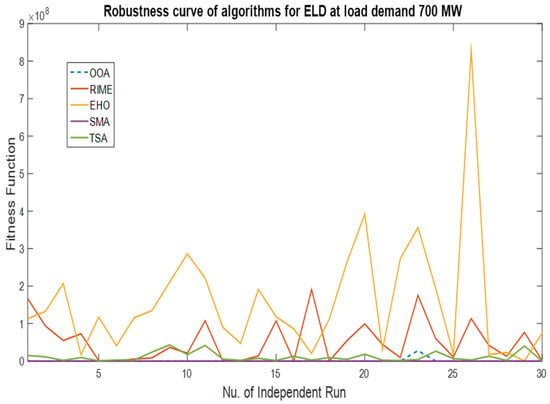
Figure 2.
Robustness curves of all methods for ELD at 700 MW load demand.
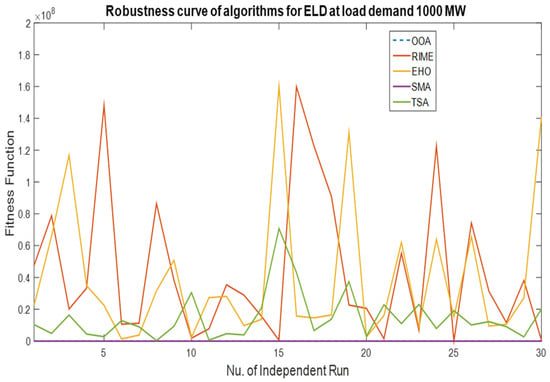
Figure 3.
Robustness curves of all methods for ELD at 1000 MW load demand.
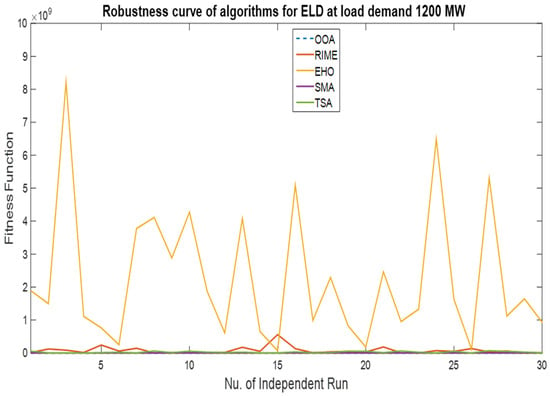
Figure 4.
Robustness curves of all methods for ELD at 1200 MW load demand.
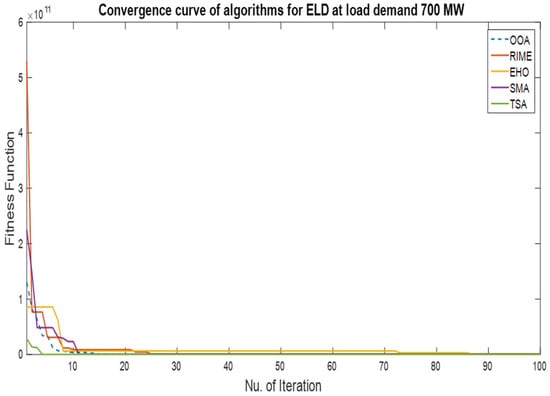
Figure 5.
Convergence curves for all methods for ELD at 700 MW load demand.
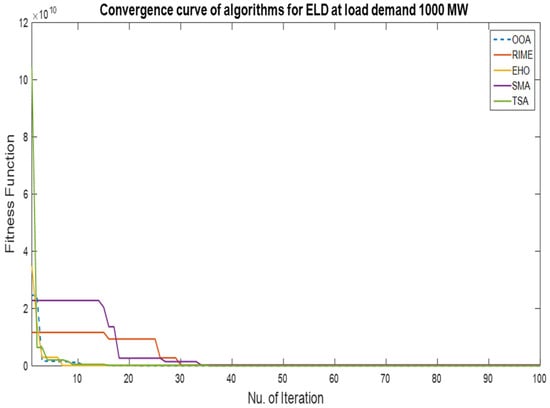
Figure 6.
Convergence curves for all methods for ELD at 1000 MW load demand.
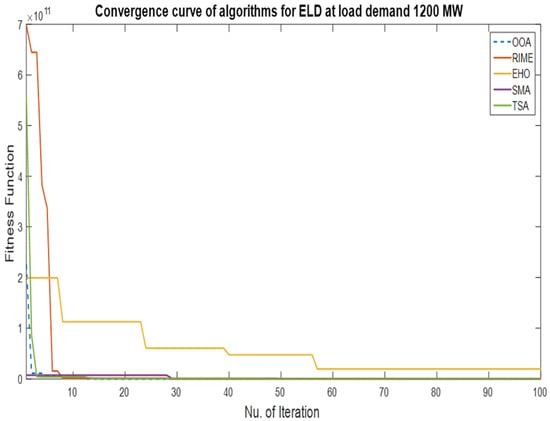
Figure 7.
Convergence curves for all methods for ELD at 1200 MW load demand.
4.2. Results of CEED Problem
A case study of 6 units at three load demand levels is presented to analyze the CEED problem. Several algorithms were applied to this problem, such as the OOA, TSA, RIME, SMA, and EHO. Thirty independent runs were applied to measure the performance of all of the competitor methods. Based on these runs, the minimum, standard deviation, mean, and maximum values were recorded as statistical data at each level of load as seen in Table 8. Based on this data, the OOA achieves the best standard deviation and the best objective function. So, the most accurate and reliable algorithm for ELD is the OOA. Table 9 illustrates the best cost of consumption fuel for all cases. Table 10 depicts the best-generated power from each unit at a 700 MW load demand based on the best fitness function for all algorithms. Table 11 shows the best-generated power from each unit at a 1000 MW load demand based on the best fitness function for all algorithms. Table 12 presents the best-generated power from each unit at a 1200 MW load demand based on the best fitness function for all algorithms. Based on the recorded results from all of the methods among the 30 runs, the robustness curve characterizes the value of the objective function among each run. Figure 8, Figure 9 and Figure 10 depict the characteristics of the robustness curve for all levels of load demand. Based on the recorded results from all of the methods among the best runs from the 30 runs that achieve the best fitness function, the convergence curve characterizes the fastest method that reaches the objective function. Figure 11, Figure 12 and Figure 13 display the characteristics of the convergence curve for all levels of load demand. Based on the robustness and convergence characteristics, the OOA achieves the optimum global solution.

Table 8.
Statistical data for CEED using all algorithms ($ per hour).

Table 9.
Minimum fitness function for CEED ($ per hour).

Table 10.
The generated power (MW) from each unit for CEED at 700 MW load demand.

Table 11.
The generated power (MW) from each unit for CEED at 1000 MW load demand.

Table 12.
The generated power (MW) from each unit for CEED at 1200 MW load demand.
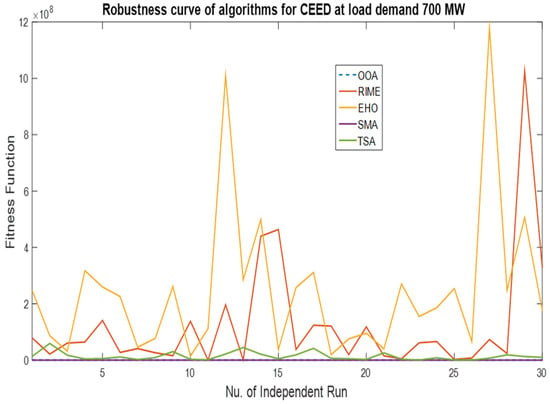
Figure 8.
Robustness curves of all methods for CEED at 700 MW load demand.
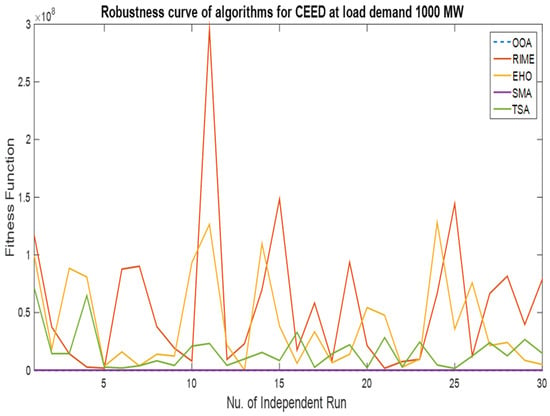
Figure 9.
Robustness curves of all methods for CEED at 1000 MW load demand.

Figure 10.
Robustness curves of all methods for CEED at 1200 MW load demand.
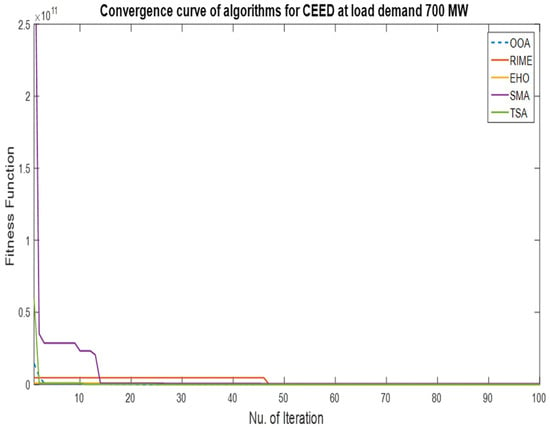
Figure 11.
Convergence curves for all methods for CEED at 700 MW load demand.
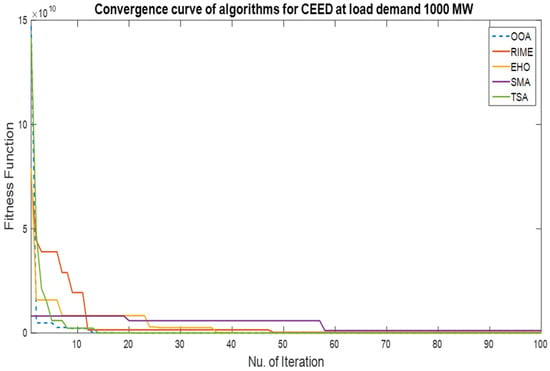
Figure 12.
Convergence curves for all methods for CEED at 1000 MW load demand.
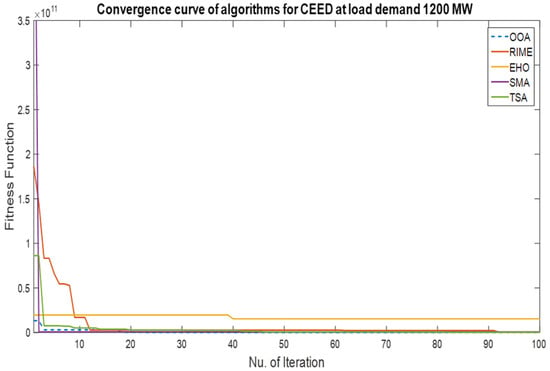
Figure 13.
Convergence curves for all methods for CEED at 1200 MW load demand.
4.3. Discussion
The main item in ELD problems is called the value of power mismatch. This is the absolute error between the units’ generated power and the summation of the demand and transmission losses. As the value of power mismatch tends towards zero, the method that extracts this value is the highest-performing technique. Table 13 contains the value of this factor for ELD and CEED. Also, the proposed OOA is matched with other techniques from the literature, such as the sine cosine algorithm, monarch butterfly optimization, an artificial bee colony, the moth search algorithm, and the chimp optimization algorithm in addition to the five methods used during the runs. Based on this data, the OOA technique achieves the best power mismatch value in all cases. The Friedman test is a statistical test used to decide the best algorithm for solving a problem. The results of the Friedman rank test are shown in Figure 14. It is observed that OOA obtains the best rank, followed by SMA then RIME, TSA, and EHO.

Table 13.
The value of ELD and CEED power mismatch.
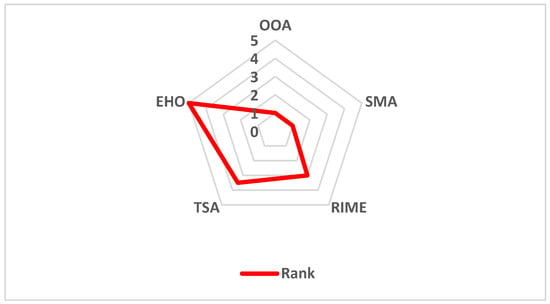
Figure 14.
Friedman rank test for all methods.
5. Conclusions
A brand new metaheuristic algorithm called the osprey optimization algorithm (OOA) imitates the way ospreys seek fish in the ocean in nature. To optimize 29 common benchmark functions from the CEC 2017 test suite, the OOA was assessed. Additionally, the effectiveness of the OOA was contrasted with the effectiveness of twelve algorithms. In this study, economic load dispatch (ELD), a crucial issue, is resolved using the OOA. ELD specifically comes in two varieties: (1) the minimization of fuel consumption costs (also known as ELD); and (2) the minimization of fuel consumption costs and emissions costs (also known as Combined Emission and Economic Dispatch, or CEED). The goal of the OOA is to maximize the economic value of the power system while minimizing the cost of fuel use, which is the main concern with optimizing the ELD problem. The primary variable in the ELD problem reflects the unit-specific allocation vector that determines the best output for each system unit. The performance of the OOA was compared to several algorithms, such as the slime mould algorithm (SMA), the rime-ice algorithm (RIME), the tunicate swarm algorithm (TSA), and elephant herding optimization (EHO). Ultimately, the findings supported the OOA’s effectiveness in cutting the cost of fuel for ELD and the cost of fuel and emissions for CEED in comparison to the alternatives. Future applications of the OOA method include resolving other large-scale, practical optimization issues related to power systems and photovoltaic energy.
Author Contributions
Conceptualization, M.S, D.S.K. and E.A.A.; Methodology, A.A.K.I., E.H.H. and M.S.; Software, M.S.; Validation, M.S, D.S.K. and E.A.A.; Formal analysis, A.S.A. and M.S.; Resources, M.S.; Data curation, A.S.A.; Writing—original draft, M.S.; Writing—review & editing, A.A.K.I., E.H.H., D.S.K., E.A.A. and A.S.A.; Visualization, M.S, D.S.K. and E.A.A.; Supervision, A.A.K.I. and E.H.H.; Funding acquisition, D.S.K. and E.A.A. All authors have read and agreed to the published version of the manuscript.
Funding
This research was funded by Princess Nourah bint Abdulrahman University Researchers Supporting Project number (PNURSP2023R409), Princess Nourah bint Abdulrahman University, Riyadh, Saudi Arabia.
Data Availability Statement
Data sharing is not applicable to this article as no datasets were generated or analyzed during the current study.
Acknowledgments
Authors thank Princess Nourah bint Abdulrahman University Researchers for Supporting Project number (PNURSP2023R409), Princess Nourah bint Abdulrahman University, Riyadh, Saudi Arabia.
Conflicts of Interest
The authors declare that there are no conflict of interest.
References
- AbdElminaam, D.S.; Houssein, E.H.; Said, M.; Oliva, D.; Nabil, A. An efficient heap-based optimizer for parameters identification of modified photovoltaic models. Ain Shams Eng. J. 2022, 13, 101728. [Google Scholar] [CrossRef]
- Ismaeel, A.A.K.; Houssein, E.H.; Oliva, D.; Said, M. Gradient-based optimizer for parameter extraction in photovoltaic models. IEEE Access 2021, 9, 13403–13416. [Google Scholar] [CrossRef]
- Houssein, E.H.; Deb, S.; Oliva, D.; Rezk, H.; Alhumade, H.; Said, M. Performance of gradient-based optimizer on charging station placement problem. Mathematics 2021, 9, 2821. [Google Scholar] [CrossRef]
- Abdelminaam, D.S.; Said, M.; Houssein, E.H. Turbulent flow of water-based optimization using new objective function for parameter extraction of six photovoltaic models. IEEE Access 2021, 9, 35382–35398. [Google Scholar] [CrossRef]
- Said, M.; Houssein, E.H.; Deb, S.; Alhussan, A.A.; Ghoniem, R.M. A novel gradient-based optimizer for solving unit commitment problem. IEEE Access 2022, 10, 18081–18092. [Google Scholar] [CrossRef]
- Farag, A.; Al-Baiyat, S.; Cheng, T.C. Economic load dispatch multi-objective optimization procedures using linear programming techniques. IEEE Trans. Power Syst. 1995, 10, 731–738. [Google Scholar] [CrossRef]
- Al-Sumait, J.S.; Al-Othman, A.K.; Sykulski, J.K. Application of pattern search method to power system valve point economic load dispatch. Electr. Power Energy Syst. 2007, 29, 720–730. [Google Scholar] [CrossRef]
- Panigrahi, B.; Pandi, V.R.; Das, S. Adaptive particle swarm optimization approach for static and dynamic economic load dispatch. Energy Convers. Manag. 2008, 49, 1407–1415. [Google Scholar] [CrossRef]
- Aoki, K.; Satoh, T. Economic dispatch with network security constraints using parametric quadratic programming. IEEE Trans. Power Appar. Syst. 1982, 101, 4548–4556. [Google Scholar] [CrossRef]
- Braik, M.; Hammouri, A.; Atwan, J.; Al-Betar, M.A.; Awadallah, M.A. White shark optimizer: A novel bio-inspired metaheuristic algorithm for global optimization problems. Knowl. Based Syst. 2022, 243, 108457. [Google Scholar] [CrossRef]
- Said, M.; Houssein, E.H.; Deb, S.; Ghoniem, R.M.; Elsayed, A.G. Economic Load Dispatch Problem Based on Search and Rescue Optimization Algorithm. IEEE Access 2022, 10, 47109–47123. [Google Scholar] [CrossRef]
- Alghamdi, A.S. Greedy Sine-Cosine Non-Hierarchical Grey Wolf Optimizer for Solving Non-Convex Economic Load Dispatch Problems. Energies 2022, 15, 3904. [Google Scholar] [CrossRef]
- Said, M.; El-Rifaie, A.M.; Tolba, M.A.; Houssein, E.H.; Deb, S. An Efficient Chameleon Swarm Algorithm for Economic Load Dispatch Problem. Mathematics 2021, 9, 2770. [Google Scholar] [CrossRef]
- Al-Betar, M.A.; Awadallah, M.A.; Zitar, R.A.; Assaleh, K. Economic load dispatch using memetic sine cosine algorithm. J. Ambient. Intell. Humaniz. Comput. 2022, 14, 11685–11713. [Google Scholar] [CrossRef]
- Al-Betar, M.A.; Awadallah, M.A.; Makhadmeh, S.N.; Abu Doush, I.; Abu Zitar, R.; Alshathri, S.; Abd Elaziz, M. A hybrid Harris Hawks optimizer for economic load dispatch problems. Alex. Eng. J. 2023, 64, 365–389. [Google Scholar] [CrossRef]
- Ramalingam, R.; Karunanidy, D.; Alshamrani, S.S.; Rashid, M.; Mathumohan, S.; Dumka, A. Oppositional Pigeon-Inspired Optimizer for Solving the Non-Convex Economic Load Dispatch Problem in Power Systems. Mathematics 2022, 10, 3315. [Google Scholar] [CrossRef]
- Kaur, A.; Singh, L.; Dhillon, J.S. Modified Krill Herd Algorithm for constrained economic load dispatch problem. Int. J. Ambient. Energy 2022, 43, 4332–4342. [Google Scholar] [CrossRef]
- Andrade, G.L.; Schepke, C.; Lucca, N.; Neto, J.P.J. Modified Differential Evolution Algorithm Applied to Economic Load Dispatch Problems. In Computational Science and Its Applications ICCSA 2023; ICCSA 2023. Lecture Notes in Computer Science; Springer: Cham, Switzerland, 2023; Volume 13956. [Google Scholar]
- Bhattacharjee, K.; Shah, K.; Soni, J. Solving Economic Dispatch using Artificial Eco System-based Optimization. Electr. Power Compon. Syst. 2021, 49, 1034–1051. [Google Scholar] [CrossRef]
- Deb, S.; Houssein, E.H.; Said, M.; Abdelminaam, D.S. Performance of Turbulent Flow of Water Optimization on Economic Load Dispatch Problem. IEEE Access 2021, 9, 77882–77893. [Google Scholar] [CrossRef]
- Gaing, Z.-L. Particle swarm optimization to solving the economic dispatch considering the generator constraints. IEEE Trans. Power Syst. 2003, 18, 1187–1195. [Google Scholar] [CrossRef]
- Choi, K.; Jang, D.-H.; Kang, S.-I.; Lee, J.-H.; Chung, T.-K.; Kim, H.-S. Hybrid algorithm combing genetic algorithm with evolution strategy for antenna design. IEEE Trans. Magn. 2015, 52, 1–4. [Google Scholar] [CrossRef]
- Banerjee, S.; Maity, D.; Chanda, C.K. Teaching learning based optimization for economic load dispatch problem considering valve point loading effect. Int. J. Electr. Power Energy Syst. 2015, 73, 456–464. [Google Scholar] [CrossRef]
- Secui, D.C. A modified Symbiotic Organisms Search algorithm for large scale economic dispatch problem with valve-point effects. Energy 2016, 113, 366–384. [Google Scholar] [CrossRef]
- Selvakumar, A.I.; Thanushkodi, K. Optimization using civilized swarm: Solution to economic dispatch with multiple minima. Electr. Power Syst. Res. 2009, 79, 8–16. [Google Scholar] [CrossRef]
- Van, T.P.; Snasel, V.; Nguyen, T.T. Antlion optimization algorithm for optimal non-smooth economic load dispatch. Int. J. Electr. Comput. Eng. 2020, 10, 1187. [Google Scholar] [CrossRef]
- Cui, S.; Wang, Y.-W.; Lin, X.; Liu, X.-K. Distributed auction optimization algorithm for the nonconvex economic dispatch problem based on the gossip communication mechanism. Int. J. Electr. Power Energy Syst. 2018, 95, 417–426. [Google Scholar] [CrossRef]
- Jayabarathi, T.; Raghunathan, T.; Adarsh, B.R.; Suganthan, P.N. Economic dispatch using hybrid grey wolf optimizer. Energy 2016, 111, 630–641. [Google Scholar] [CrossRef]
- Chiang, C.-L. Improved Genetic Algorithm for Power Economic Dispatch of Units with Valve-Point Effects and Multiple Fuels. IEEE Trans. Power Syst. 2005, 20, 1690–1699. [Google Scholar] [CrossRef]
- Nguyen, T.T.; Quynh, N.V.; Van Dai, L. Improved Firefly Algorithm: A Novel Method for Optimal Operation of Thermal Generating Units. Complexity 2018, 2018, 7267593. [Google Scholar] [CrossRef]
- Bhattacharya, A.; Chattopadhyay, P.K. Biogeography-Based Optimization for Different Economic Load Dispatch Problems. IEEE Trans. Power Syst. 2010, 25, 1064–1077. [Google Scholar] [CrossRef]
- Hazra, A.; Das, S.; Laddha, A.; Basu, M. Economic Power Generation Strategy for Wind Integrated Large Power Network Using Heat Transfer Search Algorithm. J. Inst. Eng. Ser. B 2020, 101, 15–21. [Google Scholar] [CrossRef]
- Zakian, P.; Kaveh, A. Economic dispatch of power systems using an adaptive charged system search algorithm. Appl. Soft Comput. 2018, 73, 607–622. [Google Scholar] [CrossRef]
- Farhan Tabassum, M.; Saeed, M.; Ahmad Chaudhry, N.; Ali, J.; Farman, M.; Akram, S. Evolutionary simplex adaptive HookeJeeves algorithm for economic load dispatch problem considering valve point loading effects. Ain Shams Eng. J. 2021, 12, 1001–1015. [Google Scholar] [CrossRef]
- Elsakaan, A.A.; El-Sehiemy, R.A.; Kaddah, S.S.; Elsaid, M.I. An enhanced moth-flame optimizer for solving non-smooth economic dispatch problems with emissions. Energy 2018, 157, 1063–1078. [Google Scholar] [CrossRef]
- Xiong, G.; Shi, D.; Duan, X. Multi-strategy ensemble biogeography based optimization for economic dispatch problems. Appl. Energy 2013, 111, 801–811. [Google Scholar] [CrossRef]
- Vaisakh, K.; Reddy, A.S. MSFLA/GHS/SFLA-GHS/SDE algorithms for economic dispatch problem considering multiple fuels and valve point loadings. Appl. Soft Comput. 2013, 13, 4281–4291. [Google Scholar] [CrossRef]
- Elsayed, W.T.; El-Saadany, E.F. A Fully Decentralized Approach for Solving the Economic Dispatch Problem. IEEE Trans. Power Syst. 2015, 30, 2179–2189. [Google Scholar] [CrossRef]
- Ghorbani, N.; Babaei, E. Exchange market algorithm for economic load dispatch. Int. J. Electr. Power Energy Syst. 2016, 75, 19–27. [Google Scholar] [CrossRef]
- Panigrahi, B.K.; Ravikumar Pandi, V. Bacterial foraging optimisation: Nelder–Mead hybrid algorithm for economic load dispatch. IET Gener. Transm. Distrib. 2008, 2, 556. [Google Scholar] [CrossRef]
- Kaboli, S.H.A.; Alqallaf, A.K. Solving non-convex economic load dispatch problem via artificial cooperative search algorithm. Expert Syst. Appl. 2019, 128, 14–27. [Google Scholar] [CrossRef]
- Kapelinski, K.; Neto, J.P.J.; dos Santos, E.M. Firefly Algorithm with non-homogeneous population: A case study in economic load dispatch problem. J. Oper. Res. Soc. 2021, 72, 519–534. [Google Scholar] [CrossRef]
- Shayeghi, H.; Ghasemi, A. A modified artificial bee colony based on chaos theory for solving non-convex emission/economic dispatch. Energy Convers. Manag. 2014, 79, 344–354. [Google Scholar] [CrossRef]
- Binetti, G.; Davoudi, A.; Naso, D.; Turchiano, B.; Lewis, F.L. A Distributed Auction-Based Algorithm for the Nonconvex Economic Dispatch Problem. IEEE Trans. Ind. Inform. 2014, 10, 1124–1132. [Google Scholar] [CrossRef]
- Nguyen, T.T.; Vo, D.N. The application of one rank cuckoo search algorithm for solving economic load dispatch problems. Appl. Soft Comput. 2015, 37, 763–773. [Google Scholar] [CrossRef]
- Mohammadi, F.; Abdi, H.A. modified crow search algorithm (MCSA) for solving economic load dispatch problem. Appl. Soft Comput. 2018, 71, 51–65. [Google Scholar] [CrossRef]
- Ho, Y.C.; Pepyne, D.L. Simple explanation of the no-free-lunch theorem and its implications. J. Optim. Theory Appl. 2002, 115, 549–570. [Google Scholar] [CrossRef]
- Adam, S.P.; Alexandropoulos, S.A.N.; Pardalos, P.M.; Vrahatis, M.N. No free lunch theorem: A review. In Approximation and Optimization: Algorithms, Complexity and Applications; Springer: Berlin/Heidelberg, Germany, 2019; pp. 57–82. [Google Scholar]
- Whitley, D.; Watson, J.P. Complexity theory and the no free lunch theorem. In Search Methodologies; Springer: Berlin/Heidelberg, Germany, 2005; pp. 317–339. [Google Scholar]
- Dohmatob, E. Generalized no free lunch theorem for adversarial robustness. In Proceedings of the International Conference on Machine Learning, Long Beach, CA, USA, 9–15 June 2019; pp. 1646–1654. [Google Scholar]
- Hanneke, S.; Kpotufe, S. A no-free-lunch theorem for multitask learning. arXiv 2020, arXiv:2006.15785. [Google Scholar] [CrossRef]
- Dehghani, M.; Trojovský, P. Osprey optimization algorithm: A new bioinspired metaheuristic algorithm for solving engineering optimisation problems. Front. Mech. Eng. 2023, 8, 1126450. [Google Scholar] [CrossRef]
- Kaur, S.; Awasthi, L.K.; Sangal, A.L.; Dhiman, G. Tunicate Swarm Algorithm: A new bio-inspired based metaheuristic paradigm for global optimization. Eng. Appl. Artif. Intell. 2020, 90, 103541. [Google Scholar] [CrossRef]
- Hang, S.; Zhao, D.; Heidari, A.A.; Liu, L.; Zhang, X.; Mafarja, M.; Chen, H. RIME: A physics-based optimization. Neurocomputing 2023, 532, 183–214. [Google Scholar]
- Shimin, L.; Chen, H.; Wang, M.; Heidari, A.A.; Mirjalili, S. Slime mould algorithm: A new method for stochastic optimization. Future Gener. Comput. Syst. 2020, 111, 300–323. [Google Scholar]
- Wang, G.G.; Deb, S.; Coelho, L.D. Elephant herding optimization. In Proceedings of the 2015 3rd IEEE International Symposium on Computational and Business Intelligence (ISCBI), Bali, Indonesia, 7–9 December 2015; pp. 1–5. [Google Scholar]
Disclaimer/Publisher’s Note: The statements, opinions and data contained in all publications are solely those of the individual author(s) and contributor(s) and not of MDPI and/or the editor(s). MDPI and/or the editor(s) disclaim responsibility for any injury to people or property resulting from any ideas, methods, instructions or products referred to in the content. |
© 2023 by the authors. Licensee MDPI, Basel, Switzerland. This article is an open access article distributed under the terms and conditions of the Creative Commons Attribution (CC BY) license (https://creativecommons.org/licenses/by/4.0/).